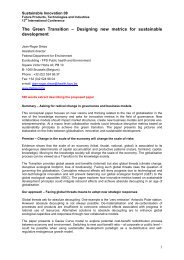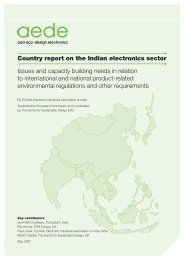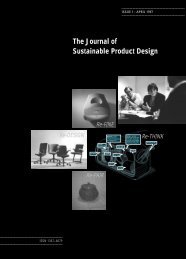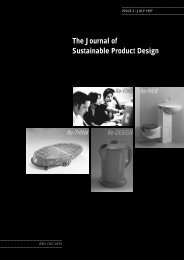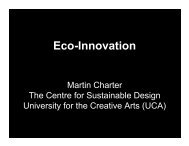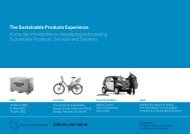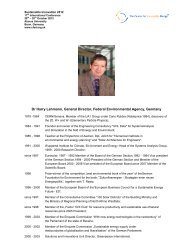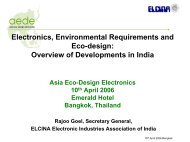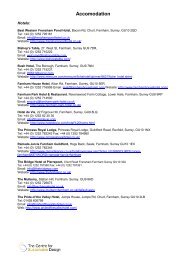acrobat JSPD 8 - The Centre for Sustainable Design
acrobat JSPD 8 - The Centre for Sustainable Design
acrobat JSPD 8 - The Centre for Sustainable Design
You also want an ePaper? Increase the reach of your titles
YUMPU automatically turns print PDFs into web optimized ePapers that Google loves.
motive was that eco-design was<br />
seen as an important aspect of<br />
product innovation. With a fourth<br />
motive being a feeling of personal<br />
responsibility felt towards ‘the<br />
environment’ by the company<br />
representative. <strong>The</strong> search <strong>for</strong><br />
environmentally benign alternative<br />
materials or components, and<br />
supply chain pressures were also<br />
strong motivations.<br />
Direct project results<br />
<strong>The</strong> 77 companies provided the<br />
following results:<br />
• eco-design had been applied to<br />
1 product that was totally new<br />
to the company<br />
• eco-design had been applied<br />
to 21 products that have been<br />
thoroughly re-designed<br />
• eco-design has been applied to<br />
13 products that were slightly<br />
improved. <strong>The</strong>se products were<br />
being or will be launched in the<br />
near future.<br />
• the packaging of another 4<br />
products was environmentally<br />
improved<br />
• in 7 companies the focus was<br />
on improving the environmental<br />
aspects of production<br />
processes<br />
• in 9 companies the product<br />
had not yet been improved, but<br />
research was being undertaken<br />
• in 11 companies the product<br />
has not been improved, but<br />
research had been concluded<br />
• in 6 companies the product<br />
had not been improved, but<br />
research was planned<br />
• in 5 companies the project<br />
had not produced any results.<br />
Focus on eco-design<br />
Some eco-design strategies<br />
proved to be more popular than<br />
others. <strong>The</strong>se eco-design strategies<br />
were recycling, reduction of<br />
weight/components, low-impact<br />
materials and high product reliability.<br />
After these four types, the<br />
most popular options concerned<br />
cleaner production, more efficient<br />
packaging, low energy-use in the<br />
use phase and the application of<br />
recycled materials.<br />
Eco-design strategies that had a<br />
greater chance of being implemented<br />
were cleaner production,<br />
the prevention of waste of<br />
energy/consumables in use phase,<br />
high product reliability, easy maintenance<br />
and repair and recycling.<br />
Indirect project results<br />
<strong>The</strong> greatest increase in ecodesign<br />
knowledge concerned ecodesign<br />
in general, environmental<br />
aspects of materials and the environmental<br />
burden of the product<br />
in its total life cycle.<br />
Most companies said that they<br />
were now able to apply ecodesign<br />
independently.<br />
• 30% had already applied<br />
eco-design principles to other<br />
products.<br />
• 60% said that they would apply<br />
eco-design in the future.<br />
• 25% said that they had<br />
developed an eco-design<br />
checklist to be used during<br />
product development.<br />
• 25% wanted to integrate<br />
JANUARY 1999 · THE JOURNAL OF SUSTAINABLE PRODUCT DESIGN<br />
INTERVIEW<br />
product-related environmental<br />
in<strong>for</strong>mation and requirements in<br />
their environmental<br />
management system.<br />
• 25% aimed to integrate environmental<br />
demands in their quality<br />
system.<br />
Commercial results<br />
• 67% expected their<br />
‘eco-designed’ products to<br />
increase their market shares.<br />
• 56% expected to enter new<br />
markets with their environmentally<br />
improved product.<br />
• 25% expected a profit to be<br />
generated through eco-design<br />
within two years, ranging from<br />
10% to 50%; 27% expected a<br />
profit ranging from 1% to 5%<br />
(profit was defined as being<br />
based on costs savings as well<br />
as sales increases).<br />
Appreciation of the IC Eco<strong>Design</strong><br />
project<br />
• 64% said that the IC Eco<strong>Design</strong><br />
project has led to concrete<br />
results.<br />
• 71% said that they would<br />
continue to use elements of<br />
the auditing method.<br />
• 90% said that they would<br />
recommend the project to<br />
other companies.<br />
This is an extract from ‘<strong>The</strong> IC<br />
Eco<strong>Design</strong> project: results and<br />
lessons from a Dutch initiative to<br />
implement eco-design in small<br />
and medium-sized companies’<br />
by Carolien G van Hemel, which<br />
originally appeared in <strong>JSPD</strong>2,<br />
July 1997).<br />
27



